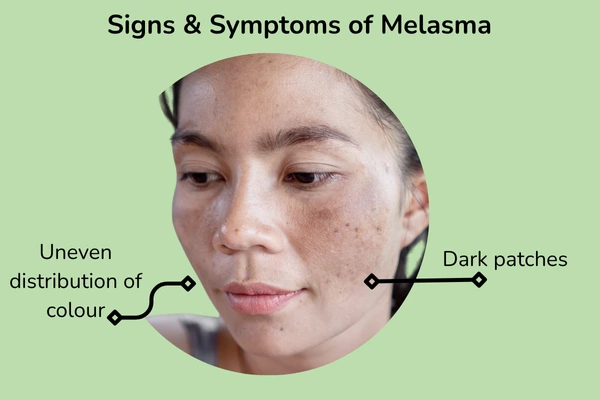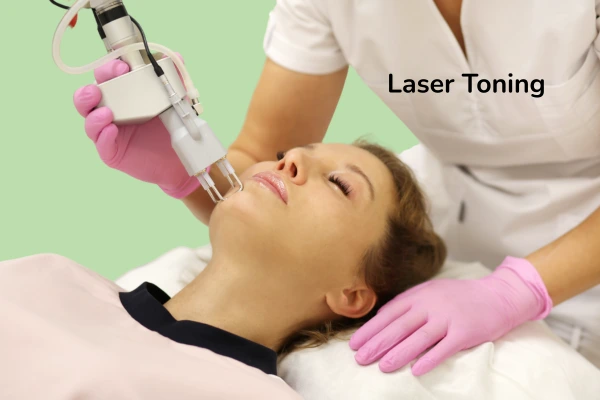Up to 25% OFF on Selected Treatments
-
Treatments
Acne and Scar
Pigmentation
Laser Hair Reduction
Dermato-surgery
Body
Anti Aging
Skin Rejuvenation
Others
- Clinics
- Blogs
Treatments
Have you started noticing brown or greyish patches on your cheeks, forehead, or upper lip? If so, you are not alone, and you may be dealing with a skin condition known as melasma. Though not medically harmful, melasma can often cause emotional discomfort and affect your personal image. For some people, the more it is noticed by others, the more emotional well-being is impacted. The real challenge? The search for the best treatments for melasma on face, which will work for the skin type and concern of the patient. With numerous melasma treatments available, ranging from creams to advanced lasers, patients often feel overwhelmed, especially when visible results take time. Here is the good news: facial melasma can be managed with the proper guidance from a dermatologist; you can certainly regain clear and even-toned skin. This blog will help you find the best melasma treatment solutions that work to treat facial melasma.
Must Read: Difference Between Melasma and Pigmentation: A Guide to Skin Discoloration
Be it advanced skincare products, in-clinic solutions, or a combination of the two, you’re on the right path. This blog lays out all of the best treatments for melasma on the face today, helps you understand how to treat facial melasma, and explains why the best treatment for melasma is not a one-size-fits-all solution. So, you make informed decisions and take steps towards radiant skin. We will explore the top three treatment options, clinically proven, dermatologist-approved, and carefully selected treatments to get rid of melasma dark patches effortlessly.
Melasma manifests as uneven brown or gray-brown pigmentation, primarily affecting facial regions such as the cheeks, forehead, upper lip, and nose bridge. These patches come into existence due to an overproduction of melanin, the pigment that colors one’s skin, hair, and eyes.
Melanocytes are specialized skin cells found in the deepest layers of the skin. Usually, melanocytes release melanin evenly to nearby skin cells, so an even skin tone is maintained. In individuals with melasma, these cells become overactive and overproduce melanin in one spot, while other areas receive very little, with the imbalance showing as discoloration.
Although the exact mechanisms of melasma are still unknown, research goes on to say that it holds many internal and external predisposing triggers. Hormonal changes, such as those occurring during pregnancy, birth control pill usage, and sun exposure, are the contributing factors in melasma. Other contributors include genetic predisposition, certain medical intake, and stress.
Melasma falls under the broader category of hyperpigmentation, but the two have distinct characteristics, causes, and treatment approaches.
| Factors | Hyperpigmentation | Melasma |
| Common Triggers | Acne scars, sun burns, eczema and wounds | Hormonal fluctuations, sun exposure and genetics. |
| Hormonal influence | Not always | Strongly linked to estrogen and progesterone |
| Photo sensitivity | May or may not be sensitive to sun light | Highly sun sensitive |
| Appearance | Anywhere on the body | Mainly on the cheeks, forehead, nose bridge, chin, and upper lip |

Let’s find out the best treatments to address melasma on the face. The below are the treatments offered by Evenly Skin and Hair Clinic that are both safe and effective. Let’s walk through the best treatments for melasma on the face, based on current dermatological standards and our in-clinic expertise.
To begin treating melasma properly, it’s essential to consult a dermatologist who has deep expertise in pigmentation conditions. At Evenly Clinic, our expert dermatologists conduct a thorough skin analysis to the extent that they can determine:
After this, these factors are taken into account while preparing a treatment plan that will be most suitable to yield good results with melasma of the face.
Topical depigmenting agents are generally the first-line treatment for melasma. At Evenly Clinic, our dermatologists prescribe dermatologist-formulated creams after carefully assessing the patient’s skin type and pigmentation severity. The formulated creams include
These ingredients are often prescribed as a combination to target melasma at multiple levels. Consistent use of these creams with proper guidance can help you get noticeable results, but remember this works well in combination with other in-clinic procedures.
For patients struggling with epidermal melasma or superficial pigmentation, chemical peels can offer immediate results, such as epitomizing their skin color and tone by reducing extra pigmentation. At Evenly Clinic, our dermatologist-administered peels are done with
Our peels are tailored to your skin sensitivity, pigment depth, and treatment history. Level 1 and 2 professional peels at Evenly provide well-controlled, safe, effective exfoliation with little to no downtime.
Must Read: Chemical Peel for Hyperpigmentation: How It Works and Benefits

At Evenly Clinic, our experts use advanced Q-switched Nd: YAG lasers for melasma treatment. It’s the most recommended laser option for persistent melasma—safe, targeted, and effective. Here’s a closer look at the process and results.
When melasma is on the forehead or when the condition presents itself as deeper dermal pigmentation resistant to topical agents and chemical peels, Q-switched laser toning is recommended. To achieve the best results, we usually advise a course of 6-8 sessions, scheduled anywhere from 2–4 weeks apart.
At Evenly, we also use an erbium laser for melasma treatment.
Must Read: Pigmentation Laser Treatment: Know pros & cons
No matter which treatment you take, proper sun protection is essential in every melasma treatment plan. Without adequate UV protection in place, the most effective treatments can be compromised. Here’s our best guidance:
At Evenly, we support every patient with an individualized sun protection strategy—including which sunscreen products are best for their skin type and lifestyle.
Must Read: How to Prevent Melasma on Face: Tips and Best Treatment
Unlike other clinics, Evenly Clinic offers a medically driven dermatologist-approved, patient-centric approach to treating facial melasma. Take a look at what makes us unique:
We recognize that each case of melasma is different. That’s why our treatment doesn’t just focus on visible pigment; it addresses the root cause and prevents recurrence for long-term skin clarity.

Closely look at these pictures and notice the transformation—
from uneven, irregular dark patches to smooth, even-toned, radiant skin.
Melasma can feel like an uphill and never-ending battle, but with the combination of the right expertise and the best treatment melasma, clearer skin is within reach. Whether you are dealing with light, mild pigmentation or dark, stubborn melasma patches, the team at Evenly Clinic is here to choose the best treatments for melasma on the face safely, effectively, and confidently.
Are you in search of “how to treat facial melasma?” Transform your skin with Evenly Clinic—reserve your consultation for a radiant, healthy glow.
Evenly Skin and Hair Clinic – HSR Layout
Third Floor, 815, 27th Main Rd, above Bluestone, 1st Sector, HSR Layout, Bengaluru, Karnataka 560102
Evenly Skin and Hair Clinic – Jayanagar
35, Ground Floor, Vinyas Arcade, 11th Main Rd, Vishya Bank Colony, 5th Block, Jayanagar, Bengaluru, Karnataka 560041
For health-related information, follow us on Instagram!!!!
What is the most effective treatment for melasma on the face?
The best treatment is based on the depth and severity of the pigmentation.
Is melasma formation permanent, or can it be cured?
It cannot be cured permanently, but with the right treatment, lifestyle changes, and proper skincare, it can be managed and lightened.
Is laser toning effective for melasma?
Yes, Q-switched ND: YAG laser technology is a safe and effective treatment option when performed by an experienced dermatologist.
Are melasma, sunspots, and freckles the same?
No, melasma is different in appearance, size, and behaviour. Freckles and sunspots appear as small skin spots that result exclusively from UV exposure.
Can men also get melasma on their faces?
Melasma is more common in women, but it also develops in men.
We hope this information is helpful. If you have any skin and hair-related questions or would like to discuss personalized solutions, please reach out to us at 7337899030. Our team of experts is dedicated to providing personalized care that meets your unique needs. Take the first step towards a healthier, more confident you by scheduling a consultation with us today. Your journey to vibrant skin and stronger hair begins here.
Book an Appointment
Start your journey to healthy skin and hair today.
Leave a Comment